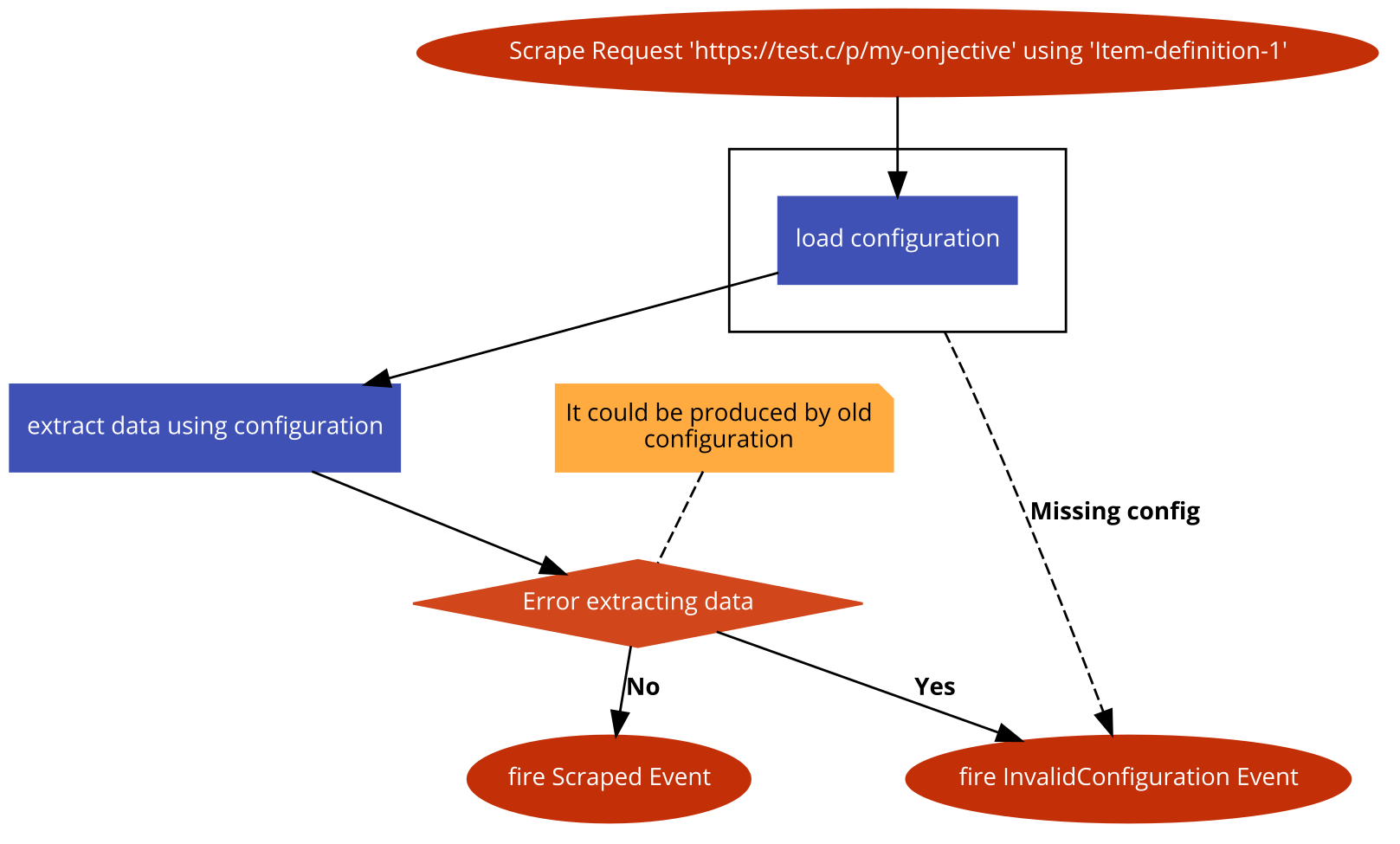softonic / laravel-intelligent-scraper
无需了解网页HTML结构即可轻松抓取网页的服务。
Requires
- php: >=7.1
- ext-dom: *
- fabpot/goutte: ^3.2
- illuminate/database: ^5.8 || ^6.0 || ^7.0 || ^8.0
- illuminate/events: ^5.8 || ^6.0 || ^7.0 || ^8.0
- psr/log: ^1.0
Requires (Dev)
- friendsofphp/php-cs-fixer: ^2.4
- mockery/mockery: ^1.0
- orchestra/database: ^3.8
- orchestra/testbench: ^3.8
- phpstan/phpstan: ^0.10.1
- phpunit/phpunit: ^7.0
- squizlabs/php_codesniffer: ^3
README
Laravel Intelligent Scraper
此包提供了一种抓取解决方案,无需了解网页HTML结构,当检测到HTML结构发生变化时自动配置。这允许您在长时间内无需手动干预继续抓取。
安装
要安装,请使用composer
composer require softonic/laravel-intelligent-scraper
要发布抓取器配置,您可以使用
php artisan vendor:publish --provider="Softonic\LaravelIntelligentScraper\ScraperProvider" --tag=config
数据库迁移已注册在服务提供者中,因此您可以执行迁移命令以创建所需的表。
php artisan migrate
依赖项
此包依赖于goutte,而goutte依赖于guzzle,因此您可以自定义客户端以满足您的需求。此包的唯一要求是您必须在处理堆栈中包含http_error中间件。
示例
<?php use GuzzleHttp\Handler\CurlHandler; use GuzzleHttp\HandlerStack; use GuzzleHttp\Middleware; use Goutte\Client as GoutteClient; use App\MyMiddleware; $client = new GoutteClient(); $stack = new HandlerStack(); $stack->setHandler(new CurlHandler()); $stack->push(MyMiddleware::getHandler(), 'my_middleware'); // Your custom middleware $stack->push(Middleware::httpErrors(), 'http_errors'); // Required middleware for the package $guzzleClient = new GuzzleClient(['handler' => $stack]); $client->setClient($guzzleClient);
默认堆栈已经包含了http_errors中间件,所以您只需要在不使用默认堆栈的情况下执行此操作。
配置
初始设置有两种不同的选项。该包可以使用数据集进行配置,或使用XPath进行配置。两种方式都能产生相同的结果,但根据您的XPath知识,您可能会偏好其中一种。我们建议使用XPath配置方法。
基于数据集的配置
第一步是了解您想从页面获取哪些数据,因此您必须转到该页面并选择所有要抓取的文本、图像、元数据等,并对它们进行标记,以便告诉抓取器您想要什么。
以微软商店的一个示例来说明:
<?php use Softonic\LaravelIntelligentScraper\Scraper\Models\ScrapedDataset; ScrapedDataset::create([ 'url' => 'https://test.c/p/my-objective', 'type' => 'Item-definition-1', 'data' => [ 'title' => 'My title', 'body' => 'This is the body content I want to get', 'images' => [ 'https://test.c/images/1.jpg', 'https://test.c/images/2.jpg', 'https://test.c/images/3.jpg', ], ], ]);
在这个例子中,我们可以看到我们想要不同的字段,我们随意标记了它们。其中一些有多个值,因此我们可以从页面抓取物品列表。
使用此单个数据集,我们将能够训练我们的抓取器,并能够抓取具有相同结构的任何页面。由于页面通常根据不同的变量具有不同的结构,因此您应该添加不同的数据集,尝试覆盖尽可能多的页面变化。抓取器将无法抓取未包含在数据集中的页面变化。
你可以检查如何工作以了解更多关于内部结构的信息。
在下一节中,我们将更深入地探讨如何创建新的数据集以及有哪些可用选项。
数据集创建
数据集由url和data组成。
url部分很简单,你只需指出你获取数据的URL。type部分为当前数据集提供了一个项目名称。这允许你定义多个类型。variant标识页面变体。标识符是基于用于获取数据的xpath构建的sha1哈希值。data部分是你指出想要获取的数据和分配你想要的标签的地方。数据可以是项目列表或单个项目。
一个基本的例子可以是:
<?php use Softonic\LaravelIntelligentScraper\Scraper\Models\ScrapedDataset; ScrapedDataset::create([ 'url' => 'https://test.c/p/my-objective', 'type' => 'Item-definition-1', 'variant' => '8ed10778a83f1266e7ffed90205f7fb61ddcdf78', 'data' => [ 'title' => 'My title', 'body' => 'This is the body content I want to get', 'images' => [ 'https://test.c/images/1.jpg', 'https://test.c/images/2.jpg', 'https://test.c/images/3.jpg', ], ], ]);
在这个数据集中,我们希望将文本我的标题标记为标题,并且我们还有一个我们希望标记为图片的图片列表。通过这种方式,我们可以灵活地逐个选择项目或在列表中选取。
有时我们想要标记一些在HTML中不干净的文字,因为它可能包含不可见的字符,如\r\n。为了避免处理这种情况,数据集允许你添加正则表达式。
使用body字段的正则表达式示例
<?php use Softonic\LaravelIntelligentScraper\Scraper\Models\ScrapedDataset; ScrapedDataset::create([ 'url' => 'https://test.c/p/my-objective', 'type' => 'Item-definition-1', 'variant' => '8ed10778a83f1266e7ffed90205f7fb61ddcdf78', 'data' => [ 'title' => 'My title', 'body' => regexp('/^Body starts here, but it is do long that.*$/si'), 'images' => [ 'https://test.c/images/1.jpg', 'https://test.c/images/2.jpg', 'https://test.c/images/3.jpg', ], ], ]);
通过这个更改,我们将确保即使body包含隐藏字符,我们也能检测到它。
重要爬虫会尝试在所有标签中找到文本,包括子标签,因此如果你定义了一个没有限制的正则表达式,例如例如/.*Body starts.*/,由于该文本在<html>元素的某个子元素中,你将在<html>元素中找到文本。因此请仔细定义正则表达式。
基于XPath的配置
在你从HTML收集了所有XPath之后,你只需创建配置模型。它们看起来像:
<?php use Softonic\LaravelIntelligentScraper\Scraper\Models\Configuration; Configuration::create([ 'name' => 'title', 'type' => 'Item-definition-1', 'xpaths' => '//*[@id=title]', ]); Configuration::create([ 'name' => 'category', 'type' => 'Item-definition-1', 'xpaths' => ['//*[@id=cat]', '//*[@id=long-cat]'], ]);
在定义中,你应该为要爬取的字段提供一个名称,并标识其类型。xpaths字段可以包含一个字符串或一个字符串数组。这是因为HTML可以根据特定页面包含不同的变体,因此你可以编写一个Xpath列表,按顺序检查以获取第一个找到的结果。
用法
配置爬虫后,你将能够使用scrape助手请求特定的爬取。
<?php scrape('https://test.c/p/my-objective', 'Item-definition-1');
有一个名为context的可选参数,允许你为scrapeRequest设置上下文,这样你就可以在你的监听器中访问该上下文。这对于你需要在你的监听器中处理一些额外数据(除爬取数据之外)很有用。
<?php scrape('https://test.c/p/my-objective', 'Item-definition-1', ['id' => 'my-objective']);
如果一切按预期进行,爬取将生成一个\Softonic\LaravelIntelligentScraper\Scraper\Events\Scraped事件。因此,请将监听器附加到该事件以接收数据。
$event->scrapeRequest->url; // Url scraped $event->scrapeRequest->type; // Request type $event->scrapeRequest->context; // Context $event->data; // Contains all the data in a [ 'fieldName' => 'value' ] format. $event->variant; // Contains the page variation sha1 hash.
所有输出字段都是数组,可以包含一个或多个结果。
如果爬取失败,将触发一个带有爬取请求信息的\Softonic\LaravelIntelligentScraper\Scraper\Events\ScrapeFailed事件。
$event->scrapeRequest->url; // Url scraped $event->scrapeRequest->type; // Request type $event->scrapeRequest->context; // Context
要附加监听器,你可以使用Laravel监听器配置,如:
// providers/EventServiceProvider protected $listen = [ Scraped::class => [ MyListener::class, ], ScrapeFailed::class => [ MyListenerFirFailedScrapes::class, ], ];
但是,所有类型的抓取都将发送到该监听器。为了简化监听器,仅监听单一类型的抓取,在scraper.php中提供了一个listeners配置,因此您可以更精细地配置监听器。
// config/scrapper.php 'listeners' => [ 'scraped' => [ 'my-type-1' => ListenerForTypeOne::class, 'my-type-2' => ListenerForTypeTwo::class, ], 'scrape-failed' => [ 'my-type-1' => ListenerFailedForTypeOne::class, ], ];
高级用法
还有一个名为ConfigurationScraped的事件,在重新配置步骤中自动执行抓取时触发。它与Scraped事件完全相同。之所以名称不同,是因为通常不希望在内部之外使用它来更新数据集。
ConfigurationScraped可用于执行更新或了解配置过程内部细节。
队列工作者
您需要一个工作者,一个用于默认队列,另一个用于configure队列。为了防止并行配置,configure工作者应该是单个工作者。
php artisan queue:work # As many as you want php artisan queue:work --queue=configure # Just one
测试
softonic/laravel-intelligent-scraper有一个PHPUnit测试套件和一个使用PHP CS Fixer的编码风格合规性测试套件。
要运行测试,请从项目文件夹运行以下命令。
$ docker-compose run test
要使用PsySH进行交互式运行
$ docker-compose run psysh
它是如何工作的?
抓取器是自动可配置的,但需要初始数据集或添加配置。数据集告诉配置器您需要哪些数据以及如何对其进行标记。
有三个服务具有独特职责,并使用事件系统连接。
抓取
它在系统接收到\Softonic\LaravelIntelligentScraper\Scraper\Events\ScrapeRequest事件时触发。可以使用我们的scrape($url, $type)辅助函数来完成此操作。
# Powered by https://code2flow.com/app
Scrape Request 'https://test.c/p/my-onjective' using 'Item-definition-1';
try {
load configuration;
}
catch(Missing config) {
goto fail;
}
extract data using configuration;
// It could be produced by old configuration
if(Error extracting data) {
goto fail
}
fire Scraped Event;
return;
fail:
fire InvalidConfiguration Event;
更新数据集
为了可重新配置并保持数据集的新鲜度,抓取器会自动存储最新抓取的数据。
# Powered by https://code2flow.com/app
Receive Scraped event;
Remove oldest scraped data;
Store scraped data;
Scrape dataset updated;
配置抓取器
如果发生InvalidConfiguration事件,系统将尝试计算新的配置以从ScrapeRequest获取信息。
# Powered by https://code2flow.com/app
Invalid Configuration for ScrapeRequest;
try {
calculate configuration;
}
catch(Cannot be reconfigured) {
goto fail;
}
extract data using configuration;
if(Error extracting data) {
goto fail;
}
Store new configuerion;
Scraped data;
return;
fail:
Fire ScrapeFailed Event;
No scraped data;
此过程可能产生两个不同的事件
- Scraped:所有工作都按预期进行,页面已抓取
- ScrapeFailed:重新计算配置后无法进行抓取,因此我们需要手动配置操作来修复它。
许可协议
Apache 2.0许可协议。有关更多信息,请参阅LICENSE。



